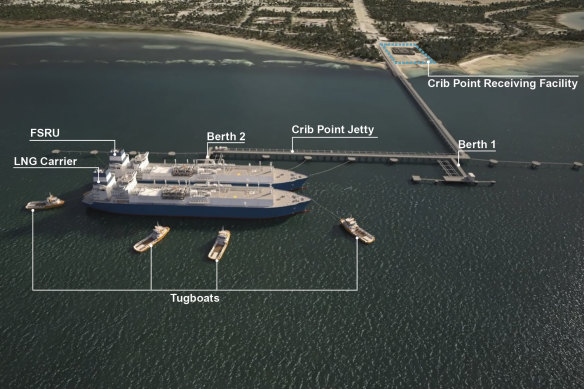The Victorian government has rejected a proposal for a gas import terminal at Crib Point in Western Port and an associated pipeline to Pakenham.
Planning Minister Richard Wynne said the proposal from power company AGL and pipeline business APA would have “unacceptable effects on the environment in Western Port, which is listed as a Ramsar wetland of international significance”.

Schematic of AGL Energy’s proposed LNG import terminal at Crib Point in Victoria’s Western Port.Credit: AGL Energy
The $250 million proposal had generated substantial local opposition, with an environment effects statement (EES) process garnering more than 6000 submissions.
That process led to an independent inquiry and advisory committee (IAC) report that was submitted to Mr Wynne in February.
“This has been an exhaustive, open and transparent process and this is the right outcome for the local community, the environment and Victoria as a whole,” Mr Wynne said.
He said the proposal had been subject to rigorous review: there were 6000 submissions and the IAC hearing went for 10 weeks. “It is probably one of the most intense EES processes we’ve had in this state in a very long time.”
AGL had been pushing its proposed terminal to import natural gas as a potential solution to winter gas shortfalls expected to hit Victoria and NSW in coming years.
While Australia is one of the world’s biggest exporters of liquefied natural gas (LNG), most is produced in the nation’s north, far away from demand centres in the south-eastern states, and is sold on long-term contracts to overseas buyers
The Australian Energy Market Operator had previously warned of winter shortages from as early as 2023 as output from traditional gas fields in Victoria’s Bass Strait rapidly declines. But earlier this week, the operator said gas shortages were not likely until 2026 if billionaire Andrew “Twiggy” Forrest’s proposed gas import terminal at Port Kembla proceeds.
The news came as AGL on Tuesday announced it would split its power generation and retailing arms in a major restructuring of the company.
AGL chief executive Brett Redman said the company was open to striking a deal with one of the other companies vying to build gas import terminals in south-eastern Australia, including Dr Forrest’s project or Viva Energy’s proposed terminal at the site of the Geelong oil refinery.
“We have been in, and I expect we will continue to be in, active discussion with every potential project if they have good volume and good price,” he said.
Mr Redman said AGL was “reviewing and considering its position” following the Andrews government’s decision.
Conservation groups on Tuesday congratulated the government for rejecting AGL’s proposal, which they said was “polluting and completely inappropriate” for Victoria.
“Gas is a polluting fossil fuel and a major cause of the climate crisis,” Environment Victoria’s Jono La Nauze said.
“The gas imported through this terminal would have created more than 8 million tonnes of carbon pollution – that’s about 7 per cent of Victoria’s current annual emissions.”
Proposal opponents included federal Liberal MP Greg Hunt, several shire councils (Bass Coast, Mornington and Cardinia), recreational fishing peak bodies, tourism operators, local business owners, and environment and climate groups.
In a statement, the Mornington Peninsula Shire said the decision would be met with widespread elation across the community after an unprecedented campaign against the project.
Mayor Despi O’Connor thanked state Labor MP Chris Brayne for working towards the outcome. “We are delighted that common sense has prevailed,” she said.
However, the shire cautioned that Mr Wynne’s report still needed to be considered by the federal Environment Minister.
Westernport and Peninsula Protection Council secretary Karri Giles said the decision would be welcomed by residents. “The feeling in the community was it was not appropriate for the area and it would put not just the environment but the community at risk,” she said.
Ms Giles, who lives in Balnarring, said the decision did not mean that all industry would be ruled out for the area in future. “There is a place for the right sort of industry. It just has to be at the right scale with minimal damage to the environment.”